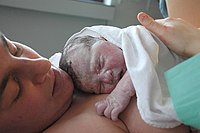
Photo from wikipedia
ABSTRACT This study aimed to explore the role of a stimulator of interferon (IFN) gene (STING) agonist in breast cancer (BCa) immunotherapy. Clinical samples were collected from 37 patients with… Click to show full abstract
ABSTRACT This study aimed to explore the role of a stimulator of interferon (IFN) gene (STING) agonist in breast cancer (BCa) immunotherapy. Clinical samples were collected from 37 patients with BCa. A tumor-bearing mouse model was established by injecting 4T1 cells into the mammary fat pad of mice. STING agonist and atezolizumab were injected in the mice twice a week for 2 weeks. Peripheral blood, tumor mass, lung, liver, brain cortex and kidney samples of the tumor-bearing mice were collected. Anti-IFN alpha receptor subunit 1 (IFNAR1) was used to treat 4T1 cells. Tumor tissues of patients with BCa exhibited lower STING and high programmed cell death protein 1 and programmed death-ligand 1 protein expressions. The STING agonist inhibited 4T1 cell growth in mice (P < 0.001) and increased the IFN-β level and phosphorylation of STING, TBK1, IRF3 and STAT1 in tumor mass of tumor-bearing mice (P < 0.001). It synergized with atezolizumab to inhibit 4T1 cell growth in mice and increased tumor necrosis factor-α, IFN-β, interleukin-10 and IFN-γ levels in the peripheral blood and tumor mass (P < 0.01). It synergized with atezolizumab to increase CD8+ cytotoxic T cells and decrease FOXP3+ Treg cells in the tumor-bearing mouse model. The STING agonist was nontoxic to the lung, liver, brain cortex and kidney. Anti-IFNAR1 reversed the STING agonist promotion on TBK1, IRF3 and STAT1 phosphorylation in 4T1 cells (P < 0.01). STING agonists enhance the efficacy of atezolizumab in BCa immunotherapy by activating the IFN-β signaling pathway.
Journal Title: Cell Cycle
Year Published: 2022
Link to full text (if available)
Share on Social Media: Sign Up to like & get
recommendations!